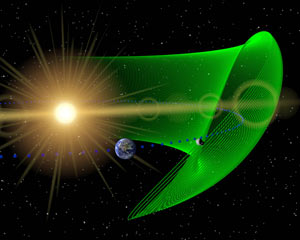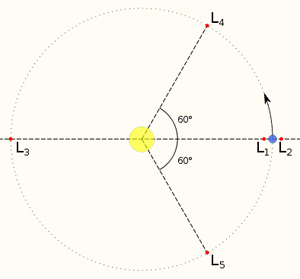Create a free profile to get unlimited access to exclusive videos, sweepstakes, and more!
WISE finds the very first Earth Trojan asteroid
NASA's Wide-field Infrared Survey Explorer (WISE) has found the very first asteroid that (more or less) shares an orbit with Earth.

NASA's Wide-field Infrared Survey Explorer (WISE) has found the very first asteroid that (more or less) shares an orbit with Earth! Called 2010 TK7, this asteroid is about 300 meters (roughly 1000 feet) across, and is the first in an up-to-now theoretical class of objects called Earth Trojans.
Here's a WISE image of the little bugger:
Doesn't look like much, does it? Of course, from 80 million km (50 million miles) from Earth it's amazing we can see it at all. Moreover, given its position in the sky, it's only up during the day as seen from Earth; it was only discovered because WISE orbits the Earth, so the sky is always dark. Also, WISE sees in the infrared, so warmer objects are easier to spot. This rock is probably around the freezing point of water or so, which, to an astronomer, is pretty warm.
So what makes this asteroid special?
If you have a large body (like the Sun) orbited by a smaller body (like the Earth), then there exist some points in space where, if you place a much smaller object (like an asteroid) it will remain there. Normally, if you put this smaller body in some random spot, the gravity of the two objects will alter its path, making its orbit unstable. But these five special places, called Lagrangian points, are stable. Well, kinda. Two are stable, in that if you put an object there it'll tend to stay there even if you poke it gently -- think of it like a small dip in flat table. Put a marble there and it'll stay put, even if you push it a little. It'll fall back into place in the center of the dip. In the diagram here, those are the L4 and L5 points.
The other three points (L1, 2 and 3) are stable as long as nothing perturbs any objects located in them; if you do poke an object orbiting there, it'll tend to keep moving. Think of each these points as a bump in the table, where you can just barely balance a marble. It'll stay there until you push it, then it rolls away. That's called an unstable equilibrium, if you want to impress people at parties.
Anyway, the first real-world (real-Universe?) example of this was found in 1906, when an asteroid was spotted in Jupiter's L4 point, 60° ahead of it in its orbit. It was named Achilles, which started the tradition of naming them after characters involved with the Trojan War (the asteroids ahead of Jupiter are named after Greeks, and the ones behind at the L5 point after Trojans). Since then, Trojan asteroids have been found for Mars as well as Neptune.
2010 TK7 is in Earth's L4 point, and is the first Earth Trojan to be found. Since this point is 60° ahead of the Earth, from our point of view any object there is up during the day (or twilight), making it really hard to spot. And it isn't just sitting out there in the L4 point, either. Remember the marble analogy? If you poke the marble, it'll move around but settle into the bottom of the dip. That's due to friction with the table. But in space there is no friction, and it's possible for objects in the L4 and L5 points to move around those points, in a sense orbiting them. Technically, there are called Lissajous orbits (pronounced "LEE-sa-jzoo"), and are stable over long periods, though the shape of the actual orbit can change.

It's all very weird, but the bottom line is that 2010 TK7 can sometimes be nearer the Earth than other times, though it never gets close enough to be a danger (it's always many tens of millions of kilometers away). As soon as I heard about this, I wondered if it would make a good target for exploration; since it's not moving much relative to Earth, it wouldn't take much fuel to get there. Unfortunately, the Lissajous orbit of the asteroid takes it well above and below the Earth's orbital plane (as shown in green in this not-to-scale diagram; click to odysseyenate), making a rendezvous difficult. That's too bad, but there are plenty of other near-Earth asteroids that make good future targets.
And still, there may be other asteroids loitering around the L4 and L5 points, smaller or darker and therefore harder to spot. Hopefully more will be found as the WISE data is mined by astronomers.
Which brings up an interesting point: Eventually, 2010 TK7 will have to be given a real name. I'll toss in my two cents here: it should be named either Coeus or Crius, the sons of Gaia, the Greek goddess of the Earth*. As far as I can tell, those names have not been used yet for asteroids, so that's a plus. We found one asteroid there, so we're bound to find another, and since those guys were brothers it seems like an appropriate investment in the future of Trojan astronomy.
[UPDATE: More info can be found on Paul Weigert's site, one of the co-discoverers of 2010 TK 7 [Update update: I have been informed that the discovery credit goes to the WISE/NEOWISE team, so my apologies]. A preprint of their paper is also available (PDF).]
*Oceanus was also a child of Gaia, but that sounds like a planet with water on it. Probably best to leave that one for an exoplanet To Be Determined Later.
Image credits: NASA/JPL-Caltech/UCLA; Wikipedia




























